Some who follow my blog know of several articles about resawing boat lumber. I’ve found various hand tool resawing techniques around the Internet, but they are usually for relatively short boards. My interest is in boat lumber, often as long as 16 feet and sometimes longer.
Many hours sitting on the sawbench and a good stack of resawn lumber has brought me to the point where I can now pull my experience together as a tutorial. That’s not to say I think myself expert, but only that I’ve learned enough to feel basically competent. There’s more to learn before claiming real proficiency. This information will help those who want to resaw lengthy pieces of softwood lumber using hand tools. It may or my not help others. For example, I don’t know how well these methods will work for tight grained hardwoods.
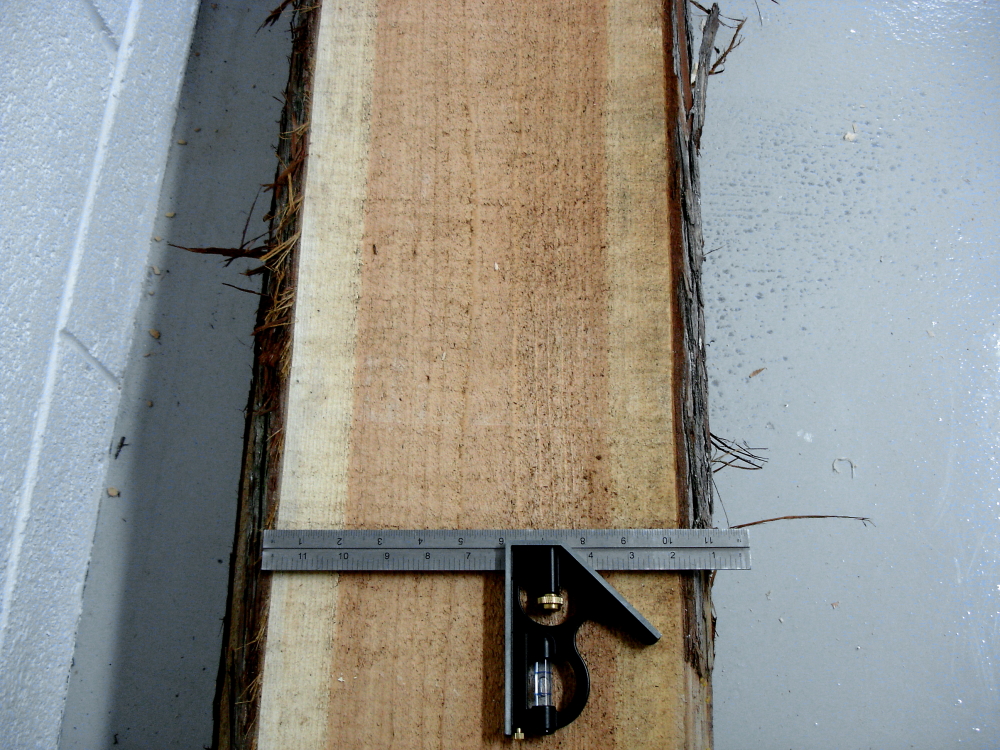 So, why resaw by hand? First, the Atlantic white cedar I use for boat lumber is more than twice as thick as I need for planking and deck material. Slicing it doubles the value of each board. I’m a skinflint who likes to avoid buying more than I need. Second, my band saw is an entry level machine that would need significant investment to get the capacity and horsepower needed for lumber up to 12 inches wide. Third, I’m a skinflint Neanderthal galoot and would rather do it myself than pay the lumber mill. Fourth, this is a hobby, not a business where time might be more important. Fifth,my hand tools are powered by Snickers Bars, and the more I use them, the more Snickers Bars I can work off.
So, why resaw by hand? First, the Atlantic white cedar I use for boat lumber is more than twice as thick as I need for planking and deck material. Slicing it doubles the value of each board. I’m a skinflint who likes to avoid buying more than I need. Second, my band saw is an entry level machine that would need significant investment to get the capacity and horsepower needed for lumber up to 12 inches wide. Third, I’m a skinflint Neanderthal galoot and would rather do it myself than pay the lumber mill. Fourth, this is a hobby, not a business where time might be more important. Fifth,my hand tools are powered by Snickers Bars, and the more I use them, the more Snickers Bars I can work off.
I’ll tell you what I’ve learned about making and tuning a saw, about holding the work pieces, about prepping a work piece, and techniques for getting good results.
Before going on, I have to recognize and thank several people. THANKS to Bob Smalser for his saw straightening and rehab tutorials on the Sawmill Creek forums and elsewhere, to Junior Strasil, also on Sawmill Creek, for his work holding and saw filing suggestions, to Peter Taran for his saw sharpening primer on the Vintage Saws site, to Josh Clark for his article on making a frame saw, and to many others who have added to discussions on the forums and in my blog comments. My success results largely from learning from these folks who graciously share their knowledge.
The Saw
My frame saw is made of oak almost exactly as Josh Clark described in his article. His design has given me a frame that is very strong and easy to handle.
Since the post about building the saw, I am on the third blade. The first was a very nice blade about 1 3/4 inches wide and quite thin. I now know that it is a “peg tooth” design (Thanks to “Saint Roy for that” definition) and is not really optimal for rip cutting. It worked OK, but slowly. Next, I tried a 3/4 inch wide 3 TPI band saw blade. It cut much faster, but also went wildly astray just as fast. The current blade is 2 inches wide, cut from a 1915 era Disston D-8 rip saw.
One of Junior Strasil’s suggestions was to file the saw teeth at 90 degrees instead of the usual 82 degrees (0 degrees of rake instead if 8 degrees of rake). This produces a more aggressive angle of attack and has worked very well. However, I had never ever sharpened a saw, and that meant learning how. I found Peter Taran’s “Saw Filing – A Beginner’s Primer,” an excellent guide. It suited my learning style. That old D-8, a few inexpensive tools, and some patience turned a reasonably decent saw into something I call “wicked sharp.” For example, when using this blade for normal ripping of 4 quarters cedar, a gentle nudge and the weight of the saw cuts about an inch per stroke.
While refiling this blade, I removed most of the set. The first couple of feet of resawing proved to “sticky,” so I added some set. Then (of course), it wanted to drift to one side, so I stoned that side. That first board has a good bit of “wandering” as I learned to tune the saw. That’s OK. I need some really thin boards for decking.
The end lesson in all this rambling about the saw is that saw sharpening is not that difficult. I see it as a gateway skill that any hand tool woodworker should be able to easily learn. The next time your saw needs sharpening, don’t send it out. Do some reading at Vintage Saws, order some files and learn a new skill.
One last suggestion. When you make your own saw, be sure to give extra attention to making edges comfortable to hold. For this kind of work, your hands will spend lots of time at the upper reaches of the uprights, and at the outer ends of the top piece.
Workpiece Prep
The cedar I use is purchased as live edge flitches. Each board is rough sawn, about 4 quarters thick, and still has bark on the edges. For each flitch, I find the widest width of heartwood I can get from it and strike chalk lines for the waste that’s to be removed. If the board is narrow enough to fit within the frame saw, I use it to rip to the lines, about 3 or 4 minutes work for each 16 foot edge. If the board is too wide for the frame saw, I put the board vertically on the front apron of my long workbench and rip with a bow saw. Depending on how careless I was sawing, a few minutes with a jack plane might be needed.
The most important part of the prep is marking center lines on the edges. I use a center marking tool and scribe these lines about 3/16 inch deep and on all 4 edges. Yes, it is worth the effort to mark the ends (well, at least one end) as well as the long edges. These deep and easily visible scribe lines are critical to getting good results.
Lastly, I mark distances in one foot intervals on the long edges. It helps quiet the idle child’s question, “Are we there yet?”
Work Holding
This had me a bit puzzled until I asked a question on one of the Sawmill Creek forums. Junior Strasil replied with a lengthy answer that led to the solution I’m using now. I already had two very nice saw benches that I built from plans by Chris Schwarz. They were a matched pair, both the same height, an important part of the answer. 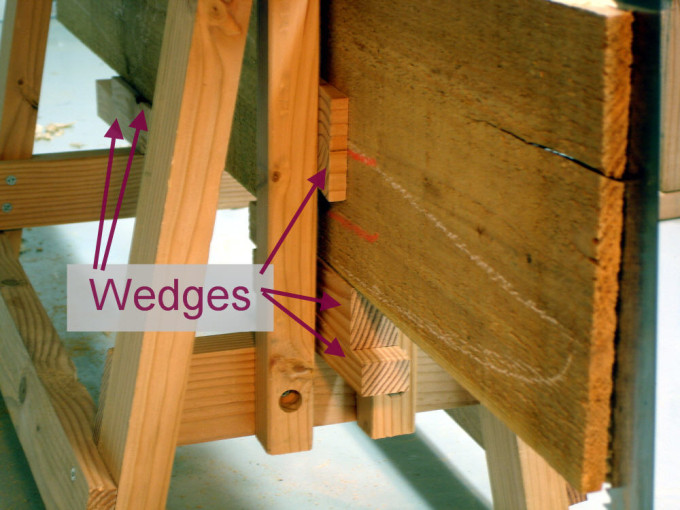
I added two vertical guides to one of the benches. Those guides form a gate that holds a board vertical underneath the bench top. Wedges in the gate keep the board absolutely vertical. I originally used wedges under the boards to clamp the up against the bench top but have since changed to using a simple f-clamp instead. It’s faster and easier to set. Recently, a wider board wouldn’t fit, so I modified the cross braces of the larger saw bench to accommodate a notch for the wider board.
Wider boards also present another problem. There’s reduced room for the length of the throw. In some pictures, you’ll see the saw benched sitting atop 2 by 4s, offering a bit more throw.
The basic setup is using the bench with the gate at the end of the board being cut, and the other bench clamped to the other end of the board to keep the board relatively level. The two benches and me sitting on one of them is enough to keep the workpiece stable.
Sawing
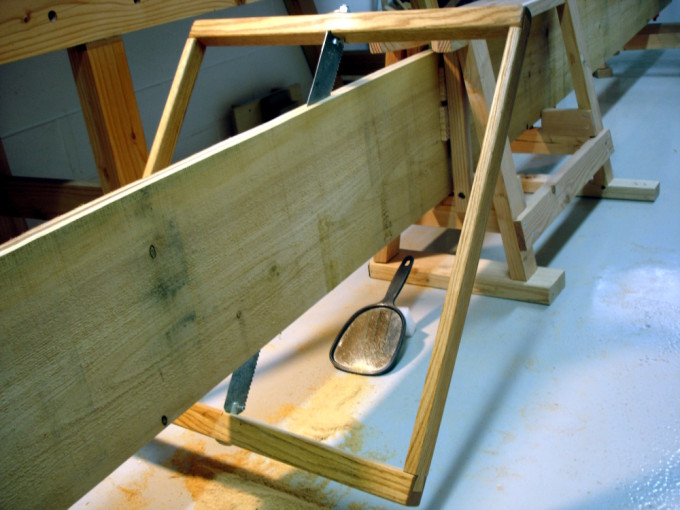
Start with the board extending 12-18 inches from the gate. Start the cut very carefully, using the scribe line on the top edge and the end to ensure as precise a start as possible. I have found several techniques useful in keeping the cut precise.
Watch the bottom of the cut with a hand mirror. Propping the mirror up at an angle helps keep it back from being directly under the cut and reduces the frequency you’ll need to clear off the sawdust.
Vary the angle of attack frequently. Sawing with the bottom edge moving away produces a long leading ramp inside the kerf on the top edge of the board. Raking the saw over in the opposite direction produces a long leading ramp inside the kerf from the bottom edge of the plank.
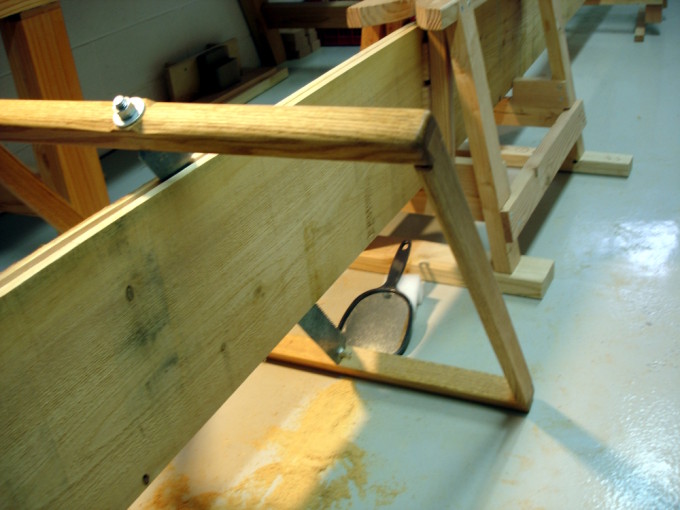
Use the mirror for this one. When you’re making a nice little curl directly from the center of the scribe line, the ramp is perfect. These ramps provide very effective guidance for the blade. Bring the blade vertical to saw away the apex of these two ramps.
Changing the sawing angles is also helpful for removing dust. There is not enough throw in the saw strokes to efficiently remove dust. That is, the tooth that starts a stroke does not continue all the way through the board to release its dust. The most dust clogging happens when sawing the upper ramp. One method that helps remove this dust is to rock the saw in an arc, kicking up the bottom with each stroke. The other sawing angles are much better for releasing dust. It really falls out easily when the saw is cutting the bottom ramp and at angles approaching that one.
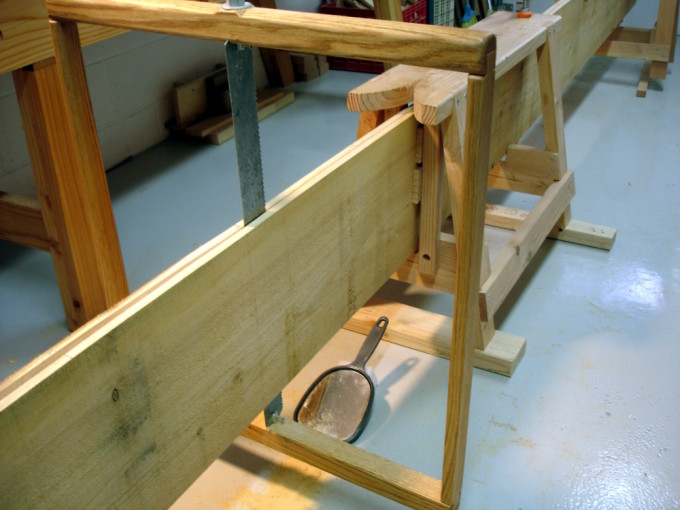
Changing these angles frequently does two things: the ramps provide guidance and the different angles of attack keep the sawing surface small and dust release effective. One might think that resawing a 10 inch wide board requires constantly sawing a 10 inch wide surface, just as a band saw does. I’ve tried it that way, and progress is much faster with the multiple angle approach.
Binding is a potential problem. The first few feet of every board produces the most pinch in the kerf. The boards want to pinch back together quite strongly until the cut moves in 3 to 4 feet. After the kerf becomes 3 or 4 feet long, tension eases and the kerf opens. Until then, thin wedges in the kerf can provide relief. It also helps to wax the saw occasionally. I use a simple candle for waxing.
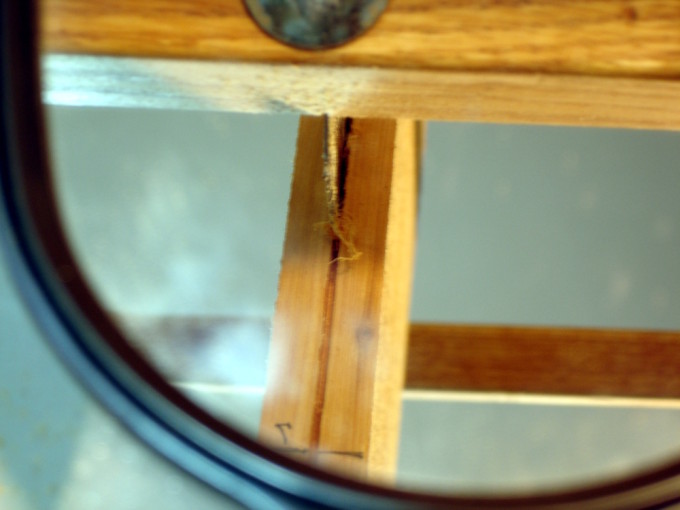
Sawing effort is moderate, and should be kept moderate. Anytime a saw is forced, it’s liable to bend away from the desired path. I have a few feet of lumber that proves that point well. When the saw is running smoothly in an open kerf and with good guidance ramps, it is easy to maintain a cadence of 60-70 strokes per minute without breathing heavily. Cutting rates depend on the width of the board. My cutting rate for an 8 inch board is almost 4 feet per hour. A 12 inch board drops to about half that. OK, OK, I hear you asking (again) if this guy’s crazy. Probably! But he’s working off those Snickers Bars.
As the Cut Progresses
We started the cut with a saw bench clamped to each end of the board. The gated bench starts, with the gate facing the end of the board, about 12-18 inches from the end of the board. As I sit on the end of the bench, I find 18 inches a comfortable reach. When the cut nears the bench, unclamp the gated bench and pull it back along the board another 12-18 inches. Recenter the board in the gate, Set the f-clamp at the tail of the bench and continue sawing. When the mid point of the board is reached, the cut ends of the boards are probably flapping around and maybe affecting the cut. That’s when it’s time to move the supporting bench from the tail end of the board to the other end.
Continue the process of periodically moving the gated bench until there’s no room to use a clamp. At this point, unclamp everything and rearrange the benches and saw so that the gated bench now has the gate facing the short end of the board, and the saw is trapped between the gate and the end of the board. It is very uncomfortable to attempt cutting by sitting on the bench and pushing the saw backwards. Get a chair of similar height and sit at the end of the board to complete the cut. Since there’s no body full of Snickers Bars sitting on either bench, some temporary weight or other constraint might be needed to keep the rig from moving. I sometimes toss a rope through the legs of the supporting bench and tie it to something immovable in the shop.
When the Cut Goes Astray
Oh, it will. This was a frequent occurrence on my first few boards. Saw tuning, and developing the multi-angle techniques have mostly eliminated the problems, but you need to know how to recover. Of course, constant use of the mirror helps spot the wandering before it gets serious. I used to keep the mirror on the bench beside me, and reach for it once in a while. After a few wanderings, I learned to keep the mirror on the floor and to watch it constantly. OK, back to recovery. Imagine that you’ve wandered off into day dreaming as you saw and the saw has wandered off too. You’ll see this at the bottom of the cut, not the top. (probability = 1.0) The best recovery I’ve found is to unclamp the workpiece and turn it over. Work at correcting the wandering from the top. Be forewarned that simply trying to use brute force to press the end of the saw back to the line will result in a nice long cupped section. Don’t ask how I know.
Next?
Some of the blog commenters have wondered whether a saw with fewer teeth per inch would cut faster. That’s very likely. A 3 tpi saw with deeper gullets might be faster. I don’t yet know. I’m at 5 tpi because that was the original filing of that old D-8 blade and it was an experiment, one that turned out quite well. I might get another old rip saw and try a 3 tpi, deep gullet version. For the time being, there’s a lot of thin spruce pieces needing ripping and I want to keep this 5 tpi blade for that work.
If there’s anyone reading this who also thinks resawing with hand tools is a good idea, leave a comment. I’d love to know there are other skinflint Neanderthal galoots around. What fuels your hand tools?
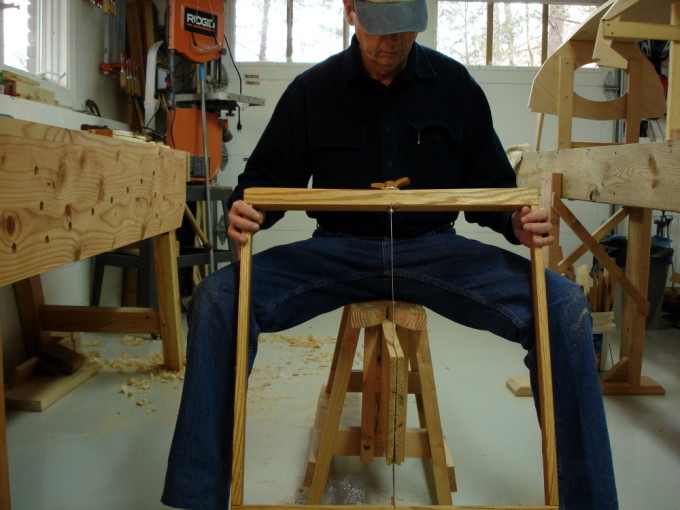
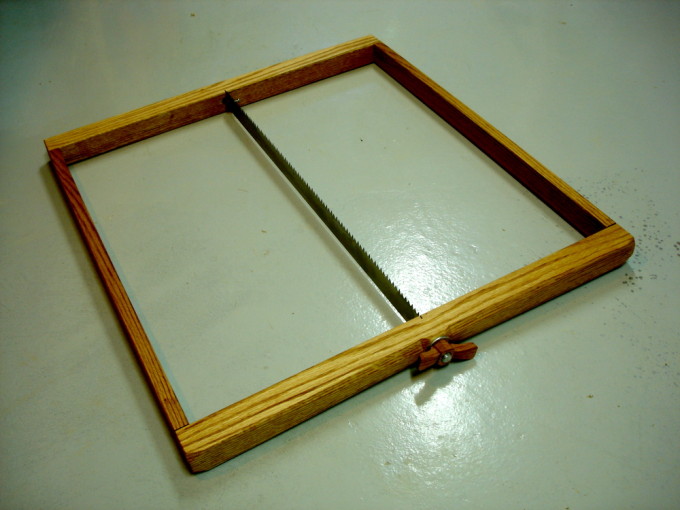
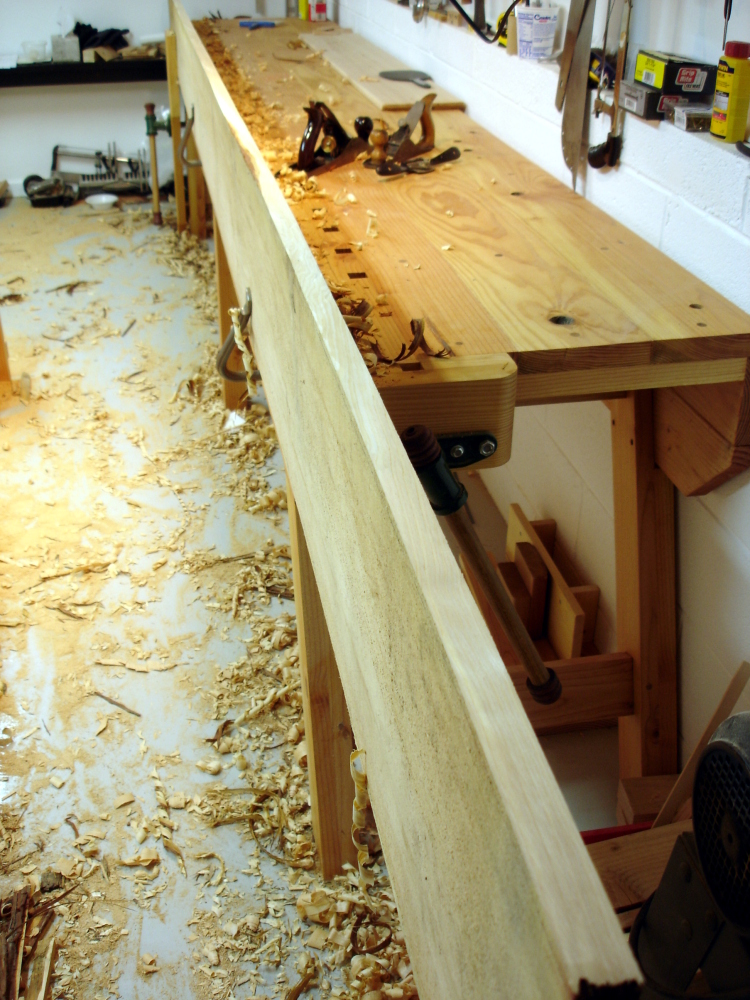
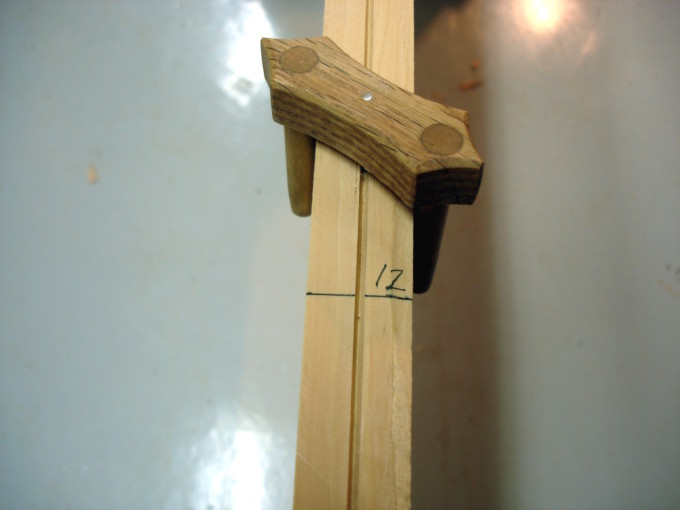
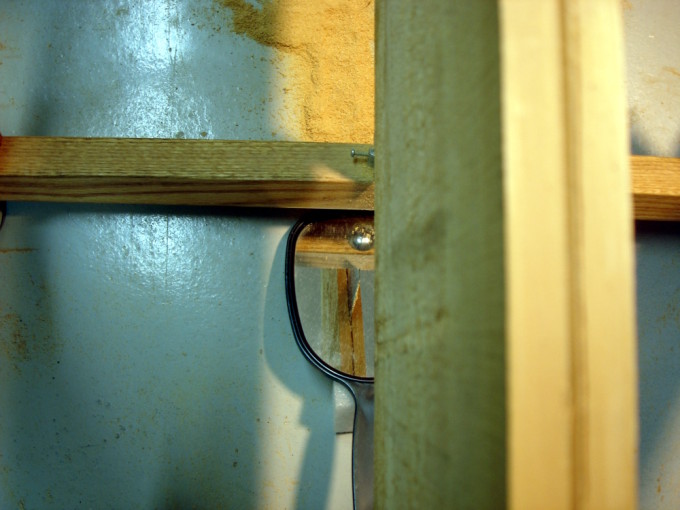
Great tutorial, all the data in one place!
Thanks,
Bob
Really good insights, Bob. I must try a frame saw on our really horribly hard Aussie hardwood!
Thanks for writing. I don’t like to rip whole piles of lumber (by any method), but there are times when it is convenient to do some pieces by hand.
I am contemplating possibly ripping a number of pieces of 15″ Southern Yellow Pine.
Having a bandsaw simply isn’t practical for me for a host of reasons right now. Building a frame saw is.
My main question is what thickness of steel I should use to make my own blade.
Luke,
That old 1915 era D-8 bade is 0.037 inch thick, about 1/32. A recent Stanley 24 inch crosscut saw measures 0.035 inch thick.
Steel quality is critical. The best saws are made of spring steel with high temper. If you’re equipped to temper the steel, have fun! If not, I suggest turning to eBay for an old rip saw. They’re readily available, cheap, and already tempered.
Great article. I appreciate the insight into fixing mistakes.
If you live in an area that has tool and die shops, you might be able to pick up some used bandsaw steel for your blade. The bands I saw last week piled in a corner for the garbage truck were 1 1/2″. Just a thought.
Thanks!
I was wondering how the resawing was going. I appreciate all the work you put into this tutorial, I hope to someday put it to use. Thanks!
Bob
You may have mentioned this before, but are you cutting on the push or the pull or both? I would have thought that a frame saw and the sitting position may make cutting on the pull easier than the push.
Cheers
Jeremy
Jeremy,
I cut on the push stroke. The weight, and the sharpness, of the saw helps make this very much easier than pulling. Always use gravity when you can. 🙂
Take a look to this old print http://www.fine-tools.com/kobiki.jpg
You can find a similar one in the DICK catalogue.
Japanese do not need any mirror but only the rigth saw.
Hello,
Thank you for taking the time away from your boat building to write the tutorial!
I had to fall an old growth yellow pine up at a friends cabin way up in the mountains. I want to cut it into planks I can work with. How well do you think your descibed technique could be adapted to would on 30 inch rounds of rough timber? I was thinking of nocking the bark off, jacking the log up on each end in an A frame, and then going at by hand similar to what you describe.
Thank you, Nice information here. I’m on a fixed income so of course I like this, can’t wait to give it a try. Thank you for sharing, it is good not to have to reinvent the wheel. Ben
Good luck with your projects Ben.
I’ve had the Hyperkitten framesaw partially constructed now for over a year. Looks like I should finish it and try it out! Meantime, I ripped a 4’x10″ birch log into flitches using a refurbished old Disston ripsaw, with the log tied down to a sawbuck made of 2×4’s. That was a lot of work, and I didn’t maintain even thickness. The log had been sitting in my garage for months after cutting, so it had some nice light spalting. I’ve also got some 2′ lenths of some kind of maple logs that I ripped using my Shopsmith bandsaw and have left stickered for the past 2 years. I’d like to use the framesaw on both of these for project-thickness boards. I have one of Chris Schwartz’s sawbenches, and one I copied from one of James Krenov’s books to match the sawbench height (two supports are always better for anything over a few feet).
Hi Steve. Yeah, get that saw done and put it to work. I found the thing that helped me the most in getting a straight true cut was the wider, thicker blade I took from a Disston rip saw. Things really took off and got very accurate when I learned how to sharpen it well. Saw sharpening is an easy skill to master and pays off handsomely.
Go finish that saw.
Hi Bob,
thank you for this great tutorial. I am reading your blog from Germany and wonder how long it took you to make the cut on the picture. Have you tried this method on hard wood? Birch?
Thank you for sharing your knowledge and please keep posting!
Hello Handwerker.
Buried in the text of the article I wrote, “My cutting rate for an 8 inch board is almost 4 feet per hour. A 12 inch board drops to about half that.”
Yes, it is slow going, but much of my enjoyment is form the work itself even if it is slow.
I have resawn a much smaller (15 cm wide) piece of Ash and that worked well. It is not as fast as softwoods, but still works. Keeping the saw well sharpened is the most important factor.
Good luck with your work.
Hi Bob, nice tutorial I am currently working on making my own planks for carpentry from smaller trees that I have cut down. When I first started I would just split the wood but I would never get nice smooth straight boards, and would always look very rustic. I decided that I should do it the right way and saw my planks. The Shopsmith 10ER I have is too small to be doing that kind of work, and I like doing things the old fashioned way anyway. I built a rig in my back yard for hand sawing my planks, but the saw I was using was taking forever. I found you’re post and am happy to find I’m not the only crazy person out there, and now know what kind of saw I should be using thank you.
Thanks Bob. I have looked at your discussion here with interest. Adam Cherubini just featured a very long frame saw (4 foot) in the latest issue of PW. He used it for resawing also but with stock clamped in a vise. His saw seemed a bit longer than what I would have opted to use as a design. It appears that your saw has a blade of about 18 inches in length. Would you recommend a longer blade length in the order of 2-3 feet for some added flexibility? I am leaning toward a 2 tpi saw and additional length would be warranted with that setup. Of course a longer blade length would necessitate a different holding setup than what you showed with clamping the wood using saw tables. Just wondering before I start building one myself. Thanks again for the thorough treatment of the subject.
Peace,
Jim Paulson
Hi Rev. Jim,
Thanks for stopping by. Hey, your chairs are beautiful! I agree with your son about that lathe; the carving really makes it work of art. Reminds me of how Kari Hultman (Village Carpenter) goes the extra mile. Earlier this afternoon, I was reading one of “St. Roy’s” books and planing to build a spring pole lathe. Now, you’ve set a new bar.
Now, that’s quite a saw Adam is using. Just picked up that copy of PW today. My saw has a blade of 22 inches. I would like longer, for a longer stroke, but compromised due to the nature of the work holding technique for those long planks.
I agree with your idea of a blade about 3 feet long. That, of course, is based on the assumption that you’ll be doing planks and panels that can be held vertically in a vise.
I also like the fewer TPI. My next blade will likely be 2 tpi, which should be better than the 5 tpi I now use. 2 should be great for softwood, I think 3-4 would be better for hardwoods.
Good luck resawing, and keep making beautiful furniture.
Hi Bob,
Nice talking with you. I appreciate the thoughful comments about my website. Hopefully, I can make a frame saw after Christmas.
Say your boat (kayak) is really neat and it must have been a joy to put in the water. I haven’t gotten into boat building yet, but maybe down the road I’ll do it. I learned a lot when I built my spring pole and treadle lathes and I’d be happy to share some thoughts if you decide to build one.
Take care,
Jim
FWIW, I have a second set of blade mounting holes off to one side of my frame saw for ripping close to one edge when the board is to wide for the space between the center mounted blade and the edge stretchers.
That’s a GREAT suggestion Junior! I’ll certainly use it the next time I need it,
Thanks!
hi again….
just re-read this article and found my answer-
I’m going to try 5 tpi and move down from there.have you had the chance to try 3 tpi since writing this post?
cheers!
Not yet Tom. Haven’t had the need yet, but think it will be very useful. There’s a piece of saw steel hangin on a peg over there, just waiting for new teeth.
Bob,
Excellent and inspiring tutorial. I love finding all the info I need in one place, concise and well explained. Thank you. I’m going out right now to build that saw and get sawing! (I also love the fact that you included the handy link for valuable information about Snickers bars)
Glad it helped Nick. Enjoy the new saw. Once you have one, you get a lot of use from it.
Hi bob,
Great saw. Planninng to build one soon. Can you possibly get some pictures of your saw blade up not the sight from different angles to show the set and the angles? Really impressed with the blog.
Thanks
Warwick
Hi Warwick,
Can’t post pics now, but the most important parts of the answers are these:
Rake is 90 degrees. The edge of the tooth is absolutely perpendicular to the axis if the blade. That’s aggressive, a little hard starting, but cuts fast. I started with a 5 TPI rip saw and reshaped the rake. Were I to do it again, I would recut to 3 TPI.
Set is almost nil. I used as little set as a gentle squeeze provides. Then I used a technique I’ve seen elsewhere to accomplish an even, minimal, set. Fold a piece of regular typing paper around the blade one layer on each side. Then, press the paper shrouded teeth in a metal vise. The result is a mere few thousandths of set.
Thanks for the thorough descriptions. I pretty exclusively use cedar, so this was an interesting read.
Hi Bob, thanks for sharing all the good nitty gritty. I bought a 100 year-old (probably more) roughly 2-foot frame saw off ebay, shipped from out east in CT, and it’s mortise-and-tenon jointed, no fasteners or glue other than the y-clamps to hold the saw, Based on this I built a whopping walnut prototype thinking the heavier the better, not so sure on that, it seems way too heavy. I’m resawing walnut slabs 1.5″ thick down to quarters for making guitars. I use the old rip saw blades that ya just can’t buy today, and like you said, I think I paid 4 bucks for the most expensive one, but I’m hoarding them with probably 10 or so for future use. I’ll share some pics and details when I can, but do you find you can resaw hardwoods to any reasonable degree? Any tips on making these work for hard dense woods would be appreciated. What a cool site you have, thanks for sharing so much…
Hello Mike,
You’re on the right path. Just keep going. Slow and easy is the biggest secret for success.
I’ve used these techniques on the soft cedar for boats, on big-box store mystery wood for various other projects, on cherry for the Words box, on African mahogany for several carved plaques.
Same tools, same techniques for all … made especially easier with a Kerfing Plane.
Good luck making great sounding guitars!